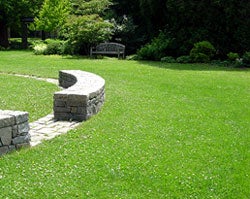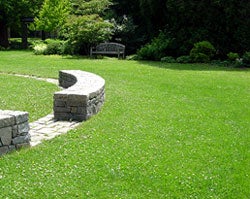 KINGSTON, R.I. — August 13, 2004 — The late summer and early fall (Aug. 15 – Sept. 15) is the best time of year to re-seed and renovate lawns. According to Alyson McCann of the University of Rhode Island’s Healthy Landscapes Program, most lawns can be restored simply by improving care and maintenance.
KINGSTON, R.I. — August 13, 2004 — The late summer and early fall (Aug. 15 – Sept. 15) is the best time of year to re-seed and renovate lawns. According to Alyson McCann of the University of Rhode Island’s Healthy Landscapes Program, most lawns can be restored simply by improving care and maintenance.
“A lawn that is healthy and well-established can out-compete most weeds and withstand a certain amount of stress from drought, insects, and disease,” she said.
With that in mind, McCann offers the following tips to help gardeners and homeowners restore their lawns to a lush and healthy green:
1. When “over-seeding” an existing lawn or establishing a new one, choose lawn grass mixes that require less fertilizers, pesticides and water. A slice-seeder is one way to introduce new seed into an existing lawn. Turf-type tall fescue and fine leaf fescues are tolerant of drought and low fertility. Endophyte-enhanced fescues and perennial ryegrass are also naturally pest-resistant to certain leaf-eating insects. Most fine leaf fescues are also shade tolerant. White clover is beneficial in lawns; it’s a legume that “fixes” nitrogen in the air and converts it to a form that plants can use.
2. Test the soil for proper fertilizer and lime recommendations and apply only the amount of fertilizer the grass actually needs. Proper soil pH and liming are very important for lawn grasses. Generally, lime can be applied at a rate of no more than 50 lbs. per 1,000 sq. ft. per application and is crucial in maintaining lawn fertility. If fertilizer is needed, consider using organic fertilizers or compost, which provide a slow, steady release of nutrients. By routinely leaving the lawn clippings on the lawn, fertilizer needs may be reduced by 50 percent or more. Fall fertilizer is best applied by mid-September to reduce pollution risk.
3. Address problems with soil compaction and thatch build-up that result in shallow roots and reduced water infiltration and air flow. Mechanical soil aeration and coring can help loosen compacted soil. Thatch is a dense layer of dead grass, stems and roots that develops between the soil surface and the growing grass. While some thatch is normal, excessive thatch problems are often a sign of over-fertilization and improper mowing. Mechanical de-thatching in the early fall is recommended for lawns with more than one-inch of thatch build-up.
Slice seeders, soil aeration and de-thatching machines can be rented at most equipment rental stores, according to McCann, or she recommends homeowners enlist the help of a landscape contractor. Soil tests can be sent to the University of Massachusetts or University of Connecticut. Order forms and instructions are available at the URI Healthy Landscapes website.
Healthy Landscapes is a project of the URI Cooperative Extension and the town of North Kingstown.

